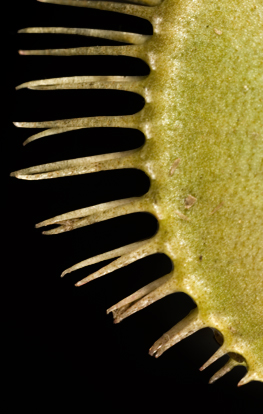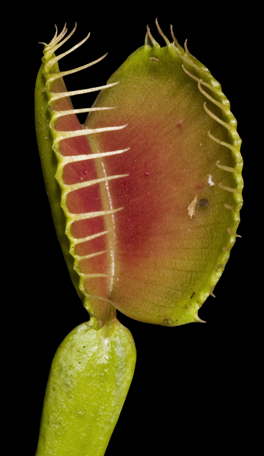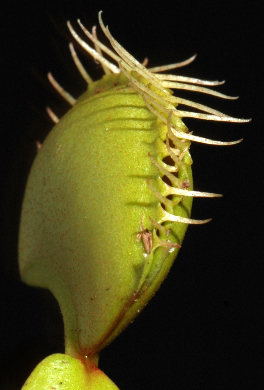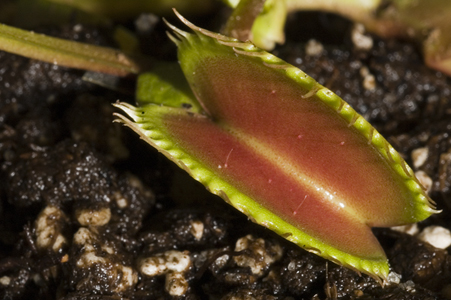

The Venus Flytrap (Dionaea muscipula) is the most recognized carnivorous plant that catches and digests mainly insects and arachnids. Its most well known characteristic is the rapid closing of the leaves when stimulated by prey. The term "Venus" comes from the Roman goddess of love. DESCRIPTION: The inner part of trap leaf contains red anthocyanin pigments. When getting plenty of bright light, the traps will turn into an intense color of red. With less than bright light, they will revert to a light green color, perhaps with only a smattering of red on the lobes. Intense or full sunlight is necessary for the survival of the plant. In most cases, the death of venus flytraps is due to poor lighting. It is highly recommended that an amount of light equivalent to bright, full sunlight is supplied. A plant in acceptable conditions will have about 4 to 8 traps on it at any given time. When grown really well, they may possess as many as 20 traps. If properly grown over the span of a few years, the entire plant can reach a maximum size of about 13cm (5 inches). They cannot get any bigger than they are already due to their evolution to capture insects, therefore they do not need larger traps for their prey. |
 |
|
| Above is a close up of the cilia (relaxed state). |
 |
MECHANISM OF TRAPPING: A venus flytrap senses prey when it detects disturbances to their leaves. There are about 3-5 "trigger hairs" located on each trapping lobe. When those trigger hairs become stimulated twice in quick succession, the ion concentrations in the leaves will increase. This will cause a signal to travel through the leaf, telling cells to change size quickly. This results in the closing of the lobes of the trap in about 0.1 second. Not all traps will shut that quickly. The speed of shutting can vary depending on general growing conditions such as the amount of light, humidity, and size of prey. If the prey inside the closed trap try to fight to get out, it will only continue to stimulate the trigger hairs some more. This will force the edges of the lobes together, eventually sealing the trap completely and forming a 'stomach' in which digestion occurs. Digestion is catalysed by enzymes secreted by glands in the lobes. Digestion takes about seven to ten days, after which the prey is reduced to a husk of chitin. The trap then reopens, and is ready for reuse. In the wild, the trap will rarely catch more than three insects in its lifetime. Otherwise, if the trap is stimulated by something that is not a prey (ie. human poking the trigger hair with some sort of object), this will still cause it to close. Because there is nothing inside to continue stimulating the trigger hair, it will open again within 12 hours. This goes the same for extremely small preys that are able to escape through the holes in the meshwork of cilia. HABITAT: In a situation where the plant is grown in a region that do not match its natural habitat, it is a good idea to replicate their native habitat. In order to become successful, it can be kept in a mini-terrarium, which will help provide much-needed humidity while being provided sunlight or strong tungsten light. The plant requires a nutrient-free soil that provides good drainage. Only purified water should be provided. A standard soil mixture of 1 part peat moss and 1 part perlite will work. Fertilizing is not a good idea because it can cause overdose of nutrient and kill the plant. FEEDING: |
|
| Above is an open trap waiting for a prey; below is a closed trap with a prey inside. | ||
 |
SET UP: The first set up is putting the plant on the labjack with a camera and handheld flash ready while on a tripod. A 105mm macro lens was used to achieve close up images. A black backdrop was used to isolate a background image. The second set up involves using a camera and 55mm lens with a bellow between for higher magnification. This allowed the photographer to achieve even closer up images such as the trigger hairs. Tensor lamps were used to keep the plant warm and to enhance the red pigment. The most challenging part in both set-up while photographing the subject was getting good lighting inside and out, and without casting unpleasant shadows. EQUIPMENT:
|
|
|
| Below: (left) a young open trap leaf with a short leaf-base; (right) a high magnified photograph of a trigger hair | ||
 |
 |
||
| SOURCES: | WHERE TO GET ONE: Anyone can get a venus flytrap through a reputable nursery or carnivorous plant society. The plant photographed came from Cook's Carnivorous Plants (USA). [www.flytraps.com] Other plant societies can be found at www.sarracenia.com/faq/faq6280. |
||
As of November 2007, Sara Gallagher is a third year student in the Biomedical Photographic Communications program at Rochester Institute of Technology, Rochester, New York. Her concentration is magnified imaging. She can be contacted at sarabeara104@yahoo.com or mt professor at mrppph@rit.edu. Return to index of articles by students on the 'Principles and techniques of photomacrography' course, November 2007, Biomedical Photographic Communications (BPC) program at the Rochester Institute of Technology (RIT). Article hosted on Micscape Magazine (Microscopy-UK). |